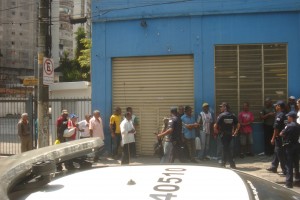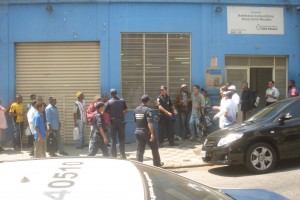Nov 3, 2010
Penaforte (en)
During the last months several friends that live on the streets showed parts of their daily realities. The following post and several others that are going to be written soon, are transcriptions of the time we spent together. The used names are not the real names of the people (if not stated otherwise) in order to protect their privacy.
N. is a friend that I met the first time in July, by coincidence, when I met with a former street resident that spend some time with me and showed and explained how the life on the streets functions. N. doesn’t live on the streets (he said that he stayed only one month on the streets, back in the 80ties) but normally spends its time with the people at Praça de Sé and other central areas such as Praça Ouvidor Pacheco E Silva.
He defines itself as a kind of ‘informal streetworker’ that always talks and discuss with the people from the streets and tries to (re)establish their self confidence, tries to give them back the feeling that they are humans as well or just listens to what they have want to say because one of the sad realities is that the streets population is nearly invisible in the eyes of the always running citizens, although their presence is massive, especially in central areas, but also throughout the city of São Paulo.
After I met him the first time we didn’t see for some weeks but ran into each other again at Praça de Sé one day. So N. invited me to go with him to lunch at Refeitório Comunitário, or usually called Penaforte, on the following Sunday. Penaforte is one of the Núcleos de Convivência that exists throughout the city. At those places, people from the street and from the Albergues normally receive, among others, free lunch, sometimes every day, sometimes at specific days. Thus, we met on the next Sunday at around 11:30 a.m in front of Penaforte which is located in Bela Vista.
Even though the doors are still closed and lunch is going to be served that day around 01:00 p.m, a huge crowd of people, probably 200+, has been gathered already and more are arriving continuously, waiting in front of the building, occupying the sidewalk and parts of the street. The crowd consisted of mainly men, a few women, maybe 5, and some gays as well.
The general atmosphere is rather depressed, people are waiting, alone, or with their own small crowd, sometime talking, often just silent. The people that are occupying parts of the streets are laying on Papelão, cardboard, the others sitting or standing.
After a while, maybe 20 minutes after we met, two cars of the Guarda Civil Metropolitana pass by, stop, and 4 policemen/women get out. The two cars got parked at the other side of the street while the 4 officers straightly approach those people laying on the cardboard, ordering them to leave the street immediately in order to return on the sidewalk, which all of them do after some discussion with those officers.
This street is not heavily frequented by cars on that Sunday and the sidewalk is already full of people, forming a line from the entrance of Penaforte until the end of the facade of the neighboring, empty/abandoned, building.After that intervention, the officers return to the other side of the street where one of their cars is still parking, waiting in the shadow of the adjacent building while observing the scene. The other police car is passing by once in a while.
Time passed by and suddenly, two men from the crowd near the entrance start to argue, first shouting loud, then start to fight, mainly pushing each other around. The reason is not obvious because we also stay on the other side of the street, talking. The waiting police is intervening immediately, trying to separate the two with batons in their hands, shouting on them and pushing them away from each other. Volunteers from Penaforte joining the scene as well, trying to calm down the two guys as well as the police.
N. said that its sad to see that the people are still fighting against each other although they are all in similar situations. In this case the fight was probably for a better position in the line in order to enter faster and receive the lunch earlier.
After a while, the scene is quite again, the police returned to other side of the street and the people are finally entering the building because the lunch is ready. Inside, we enter a huge hall, mainly equipped with tables and chairs, so crowded that there is no space for everybody to sit. Because we entered at last, we had to wait standing as well.
Penaforte functions according to the following schema: in order to receive lunch one must be registered at this institution, thus, everybody that goes there has a kind of paper that shows that he or she is registered. This paper must be shown at the entrance, additionally, everybody puts his or her name in a list of attendance. Among food that gets served, the place offers medical support once a month, has a small library, a small basketball/football field in the backyard, and offers several workshops such as creation of artesian crafts. Refeitório Comunitário is maintained by RedeRua in cooperation with the Prefeitura da Cidade de São Paulo.
On this Sunday, the people formed groups in order to receive their lunch blockwise. When I was there some days before, the lunch was distributed directly in the huge hall to everybody, this time, a block of people received their lunch in the basement floor, thus the next block of people had to wait until the current one finished. 4 or 5 blocks of people have been formed, which finished their lunch altogether in about one and a half hour.
Inside, the atmosphere is still very dense and depressing, people are not talking much, just waiting for their food. After they finished, everybody leaves soon, just a few of them stay a bit longer, talking to the assistants and volunteer workers. N. and I stay longer as well, talking with one of the assistants and a young guy that lives in an Albergue close by.
After some time, we leave as well, together with the guy, in order to take a walk to the center, chatting about the coming elections (which are over since last Sunday). For the young guy, none of the candidates are an option because the situation on the street never improved during the last years, instead, it became more and more difficult, with more and more people entering the streets, thus he don’t believe any of the politicians and prefers not to vote at all. Another interesting of his notations is related to the non-access to information concerning the street population. He gives the example that he stays in an Alberque in the central area and don’t know when a new Alberque gets opened or closed, this kind of information never arrives at him. Thus, a better distribution of important information would already be a help. From there we entered the question of mobile phones and the ridiculous high price for calls determined by any operator in Brazil, which simply doesn’t allow him to afford and use one (see also Horst, 2009).
Finally, right before we split to go our own ways, we made an appointment to meet for lunch at the following Tuesday at the Centro Franciscano De Reinserção Social , a similar place, run by the Franciscan church.
Links
Prefeitura da Cidade de São Paulo, 2004. Pesquisa de Legislação Municipal, São Paulo: SAS. Available at: http : / /www3 .prefeitura .sp .gov .br /cadlem /secretarias /negocios _juridicos /cadlem /integra .asp ?alt =04082004P +000152004SAS [Accessed November 2, 2010].
Prefeitura da Cidade de São Paulo, 2010a. Portal da Prefeitura da Cidade de São Paulo. Portal da Prefeitura da Cidade de São Paulo. Available at: http : / /www .capital .sp .gov .br /portalpmsp /homec .jsp [Accessed November 2, 2010].
Prefeitura da Cidade de São Paulo, 2010b. Secretaria Municipal de Segurança Urba na. Portal da Prefeitura da Cidade de São Paulo. Available at: http : / /www .prefeitura .sp .gov .br /cidade /secretarias /seguranca _urbana /guarda _civil / [Accessed November 2, 2010].
Rede Rua, 2010a. Associação Rede Rua. Associação Rede Rua. Available at: http : / /www .rederua .org .br /index .php ?option =com _frontpage &Itemid =1 [Accessed August 30, 2010].
Rede Rua, 2010b. Refeitório Comunitário do Povo da Rua. Associação Rede Rua. Available at: http : / /www .rederua .org .br /index .php ?option =com _content &task =view &id =4 &Itemid =7 [Accessed November 2, 2010].
Locations
r3cl41m, 2010a. Centro Franciscano De Reinserção Social. Available at: http : / /www .openstreetmap .org /browse /node /913381513 [Accessed November 2, 2010].
r3cl41m, 2010b. Praça da Sé. Available at: http : / /www .openstreetmap .org /browse /way /75488634 [Accessed November 2, 2010].
r3cl41m, 2010c. Praça Ouvidor Pacheco E Silva. Available at: http : / /www .openstreetmap .org /browse /way /75488635 [Accessed November 2, 2010].
r3cl41m, 2010d. Refeitório Comunitário de Povo da Rua. Available at: http : / /www .openstreetmap .org /browse /node /913381460 [Accessed November 2, 2010].
References
Horst, H., 2009. New Media Practices in Brazil, Part V: Mobile Phones. Futures of Learning. Available at: http : / /futuresoflearning .org /index .php /Firda _08 /comments /new _media _practices _in _brazil _part _v _mobile _phones / [Accessed November 2, 2010].


